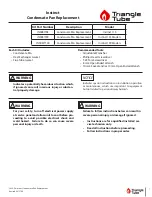
30
EN
Air throttle
Provided that the diameter of the air nozzle has been correctly selected
in correspondence with the demanded firing capacity, and the gap bet-
ween the air nozzle and the oil nozzle also meet the requirements, the
combustion airflow will be adjusted through the air throttle.
The blower pressure will be reduced by turning the setting screw counter
clockwise, which increases the CO
2
content of the exhaust gases. By turn -
ing the setting screw clockwise the blower pressure will be increased and
consequently the CO
2
content reduced. For measuring the blower
pressure, a pressure measurement nipple has been inlcuded at the nozzle
cover. The reference values for the blower pressure are provided in the
basic setting table (see Chapter 5).
Adjustment of flue gas re-circulation
By turning the setting
screw clockwise for the
re-circulation gap, the
width of the gap will be
decreased and conse-
quently the re-circled
flow of flue gas redu-
ced. As a result the NO
x
content of the flue gas
will slightly increase. In
the opposite case, an
increase of the re-circu-
lation gap by turning
the setting screw coun-
ter-clockwise will cause an intensification of the flue gas re-circulation by
which the NO
x
content of the flue gases reduces. However, the flame sta-
bility will reduce with the rising rate of re-circulation. This behaviour sets
tight limits to the flue gas re-circulation as a measure for the NO
x
re-
duction, i.e. that the flame will be lost (tear-off) at the gap of re-circulation
that has been opened too far, particularly when starting the burner. This
is due to the fact that the combustion chamber during the start-up phase
contains air, but not flue gases, as during the operation of the burner. The-
refore, it is the re-circulation of air, which makes the mixture poor of fuel,
and consequently less ignitable. In addition, the entry of air has a negative
effect on the stabilisation mechanism of the flame. In light of this we re-
commend keeping the measurements for the re-circulation gap as stated
in the base setting table. In this connection you must observe that the
minimum gap width is limited to 2 mm by a mechanical stop.
In view of flame stability, the start-up of the burner at a cooled combustion
chamber represents the most unfavourable case. In order to ensure a
start-up under these circumstances the water contained in the boiler
should be cooled as far as possible, and thereafter an attempt to start
should be subsequently carried out. In the event of a non-occurring or
pulsating start-up you should decrease the re-circulation gap.
Adjustment of the oil mass flow
The injected oil mass
flow derives from the
size of the nozzle and
from the injection pres-
sure that has been set
on the pressure con-
troller at the oil pump.
By turning the setting
screw clockwise the oil
pressure will conse-
quently increase and
also therefore the in-
jected oil mass flow. In
the opposite case the
oil pressure will reduce
by turning the setting screw counter-clockwise. For measuring the oil
pressure a pressure-measuring controller at the pump has been included.
Corresponding pressure-measuring devices, as well as fitting accessories,
contains the portable testing case for the pump that is detailed in chapter
10.3. Reference values for the sizes of nozzle and oil pressure may be
taken from Chapter 5 of the base setting table.
4.
Maintenance of the burner
In case of maintenance you should loosen the service screw at the flange
with a 4 mm hexagon screw, then turn the burner to the left side and pull
it out of the burner tube. You should then suspend the burner by the eye
in the base plate (model with cover cap), or by the eye at the burner hou-
sing (model without cover cap) on the service screw of the flange. This
so-called service position ensures an ideal access to all components in
the vicinity of the mixing device.
Attention:
The mixing head and the ignition electrode may be very hot. Risk of injury!
Service position
Exchange of the nozzle and the diaphragm valve
– Loosen the fastening screw for the mixing head with a hexagon key
(4 mm) and take off the mixing head.
– Choose a suitable oil nozzle according to the basic adjustment table
(see Chapter 5.).
– Unscrew the existing oil nozzle.
– Carefully examine the worn out nozzle: If traces of heavy thermal stress
(coke formation on the outer jacket, gummy coke products on the
nozzle filter) are visible, we also recommend the immediate exchange
of the diaphragm valve. In this case pull out the diaphragm valve from
the oil pre-heater by means of a M5 screw and insert a new diaphragm
valve (order no.: 10021.00003). For an easy exchange of the diaphragm
valve the knurled screw (order no.: 10023.00026) is available as an ac-
cessory.
– Screw in the new oil nozzle.
– Place the mixing head onto the oil pre-heater.
– Adjust the gap between the air nozzle and the oil nozzle according to
the dimensional drawing. Depending on the respective model 1-4 dis-
tance rings have already been mounted on to the oil pre-heater by the
factory. Alternatively you may determine the gap by means of a Vernier
depth gauge. Subsequently you should fix the mixing head through the
fastening screw at the adjusted position.
– For obtaining a reliable mixing ignition the gap between the two endings
of the electrodes must be 3 mm. If necessary, you should re-adjust the
electrodes. The adjustment gauge gauge (order no.: 10004.00274) that
is available as an accessory may be very helpful.
Setting screw
for the air throttle
Pressure measurement
nipple
Setting
screw for
recirculation
Setting screw for
the oil pressure
Oil nozzle
Fastening screw
for mixing head
Distance ring
















































